
According to apocrypha, as well as Christian and Islamic tradition, Saint Anne was the mother of Mary, the wife of Joachim and the maternal grandmother of Jesus. Mary's mother is not named in the Bible's canonical gospels. In writing, Anne's name and that of her husband Joachim come only from New Testament apocrypha, of which the Gospel of James seems to be the earliest that mentions them. The mother of Mary is mentioned but not named in the Quran.
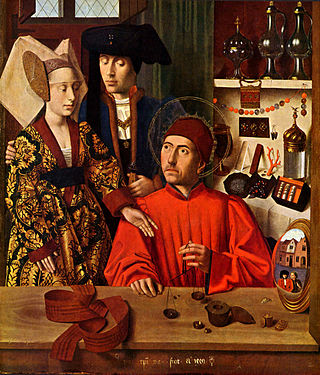
Eligius, venerated as Saint Eligius, was a Frankish goldsmith, courtier, and bishop who was chief counsellor to Dagobert I and later Bishop of Noyon–Tournai. His deeds were recorded in Vita Sancti Eligii, written by his friend Audoin of Rouen.
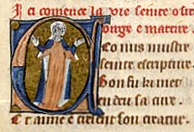
Osgyth was a Mercian noblewoman and prioress, venerated as an English saint since the 8th century, from soon after her death. She is primarily commemorated in the village of St Osyth, in Essex, near Colchester. Alternative spellings of her name include Sythe, Othith and Ositha. Born of a noble family, she became a nun and founded a priory near Chich which was later named after her.
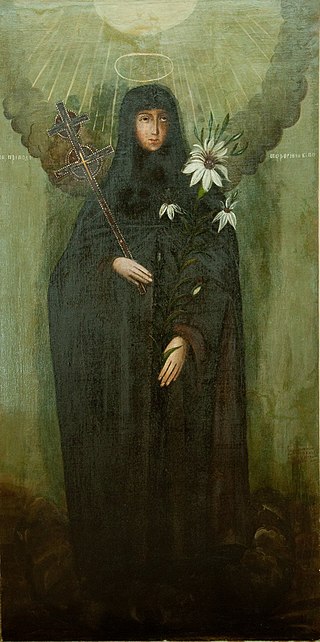
Euphrosyne of Polotsk was the granddaughter of Vseslav, the prince of Polotsk, and daughter of the prince Svyatoslav-Georgy Vseslavich. She has long been a popular saint among Orthodox devotees, particularly those in Belarus, Ukraine, and Russia with a traditional feast day of May 23. In addition, since 1984, she has been one of the 15 patron saints of Belarus, whose lives are celebrated in the Belarusian Orthodox Church, on the first Sunday after Pentecost.
Acarius, venerated as Saint Acarius, was a monk of Luxeuil Abbey who became Bishop of Doornik and Noyon, which today are located on either side of the Franco-Belgian border.

In Christianity, the Visitation, also known as the Visitation of the Blessed Virgin Mary, refers to the visit of Mary, who was pregnant with Jesus, to Elizabeth, who was pregnant with John the Baptist, in the Gospel of Luke, Luke 1:39–56. The episode is one of the standard scenes shown in cycles of the Life of the Virgin in art, and sometimes in larger cycles of the Life of Christ in art.

Audoin, venerated as Saint Audoin, was a Frankish bishop, courtier, hagiographer and saint. He authored Vita Sancti Eligii which outlines the life and deeds of Eligius, his close friend and companion in the royal court and the Church.
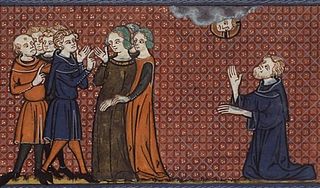
Pelagia, distinguished as Pelagia of Antioch, Pelagia the Penitent, and Pelagia the Harlot, was a Christian saint and hermit in the 4th or 5th century. Her feast day was celebrated on 8 October, originally in common with Saints Pelagia the Virgin and Pelagia of Tarsus. Pelagia died as a result of extreme asceticism, which had emaciated her to the point she could no longer be recognized. According to Orthodox tradition, she was buried in her cell. Upon the discovery that the renowned monk had been a woman, the holy fathers tried to keep it a secret, but the gossip spread and her relics drew pilgrims from as far off as Jericho and the Jordan valley.

"Le bon roi Dagobert" is a French satirical anti-monarchical and anti-clerical song written around 1787. It references two historical figures: the Merovingian king Dagobert I and his chief advisor, Saint Eligius (Éloi), the bishop of Noyon. The song is directed against Louis XVI and the ties maintained by the Catholic Church with the ancien régime, but it was used more broadly against monarchies in French history.

Mildburh was the Benedictine abbess of Wenlock Priory. Her feast day is 23 February.

Godeberta was a saint and abbess. She was born of "pious parents" in Amiens, France, north of Paris. Her parents were nobles attached to the king's court, so she was carefully educated. When Godeberta was old enough, her father took her to the king's court to obtain permission to "marry her to someone of suitable rank and fortune". Saint Eligius, who was present at court, was able to see that she wanted to "dedicate her virginity to God", and took off his episcopal ring and placed it on her finger in the presence of the king, pronouncing her a nun. Godeberta refused offers of marriage by her noble suitors, and the king, impressed with her zeal and conduct, endowed Godeberta with a small palace in nearby Noyon, north of France, with a chapel dedicated to Saint George. She turned her home into a monastery, where she was abbess for 12 young women. She chose Eligius as her spiritual guide.
Sidonius was an Irish-born French monk and saint. He was the spiritual teacher of Leutfridus. He is venerated in the Roman Catholic Church and Eastern Orthodox Church.
Austrebertha was a French nun of the Middle Ages, who took the veil very young, and became a nun at the Port Monastery in the Ponthieu. She became abbess to the foundation of Pavilly, where she died at the beginning of the eighth century, at 74. She is venerated as a saint in the Catholic and Eastern Orthodox Churches. Her feast day is February 10.

Euphrasia was a Constantinopolitan nun who was venerated after her death as a saint for her piety and example of charity.

Rictrude was abbess of Marchiennes Abbey, in Flanders. The main early source for her life is the Vita Rictrudis, commissioned by the abbey, and written in 907 by Hucbald.

Lucy Filippini is venerated as a Catholic saint.

Paulus of Verdun (576-648) was a bishop of Verdun in the Lorraine region of France from 630 until his death in 647 or 648.
Adalsinda or Adalsindis of Hamay and Eusebia of Douai, were 7th-century Columban nuns, who were sisters from a prominent Merovingian family; Eusebia became an Abbess. They are venerated as saints in the Catholic and Eastern Orthodox Churches. Their parents were Richtrudis, a Gascoigne-Basque heiress, and Adalbard I of Ostrevent, a Frankish duke of Douai. Both mother and father are also recognised as saints, as are another sister, Clotsinda, and a brother, Maurontius. They are especially venerated in Northern France and Flanders.
Pelagia the Virgin, also known as Pelagia of Antioch, was a Christian saint and virgin martyr who leapt to her death during the Diocletianic Persecution in refusal to offer a public sacrifice to the pagan gods by Roman soldiers, or to do "something unspeakable ", typically inferred as the Roman soldiers attempting to rape her. She is venerated as a saint in the Eastern Orthodox Church and Roman Catholic Church.
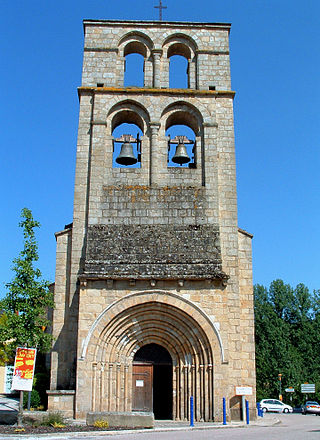
Saint Thillo was a Saxon slave who was converted by Saint Eligius and became a priest at Solignac Abbey. He accompanied Eloi in missionary work, returned to Solignac, and was made abbot. Unable to handle the responsibility, he left the abbey and became a hermit. His feast day is 7 January.














